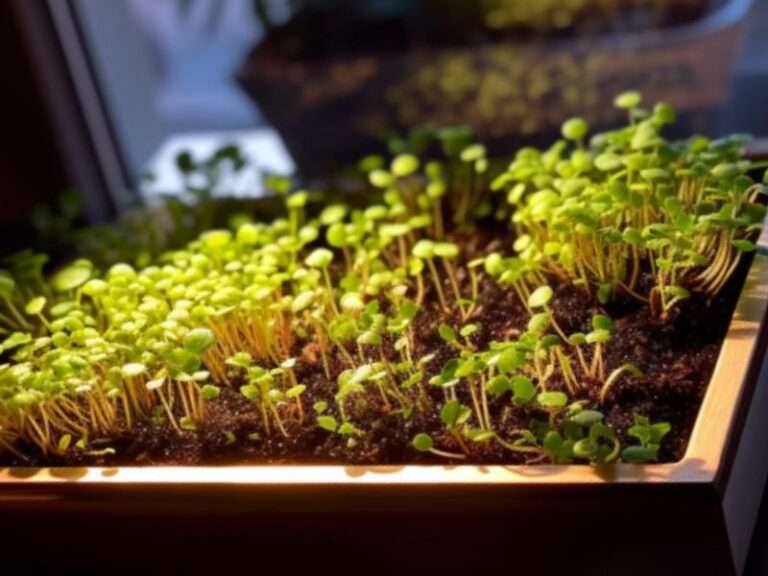Microgreens Seeds: 10 Varieties You Must Try for a Flavorful and Healthy Harvest
Some of our posts on Microgreensguru.com contain affiliate links. If you click on an affiliate link and make a purchase, we may receive a commission. Clicking on an affiliate link that earns a commission does NOT result in additional charges or costs you extra. Earnings from affiliate links help keep this website running. See our full affiliate disclosure here.
Are you looking to enhance the flavor and nutrition of your meals? Look no further than microgreens seeds! These tiny but mighty greens are packed with intense flavors and a wide range of health benefits.
In this article, we will explore why microgreens seeds are a must-try for a flavorful and healthy harvest, as well as introduce you to 10 varieties that you simply have to try.
When it comes to adding depth and complexity to your dishes, microgreens seeds are the way to go. These young seedlings may be small in size, but they pack a powerful punch when it comes to taste. From spicy radishes to earthy beet greens, these little greens offer a burst of vibrant flavors that can elevate any dish from ordinary to extraordinary.
Not only do they add an explosion of taste, but they also come with an array of nutrients such as vitamins A, C, and K, as well as minerals like iron and potassium. So if you’re looking for a delicious and nutritious addition to your diet, give microgreens seeds a try!
Key Takeaways
- Microgreens seeds offer a flavorful and healthy harvest.
- There are 10 varieties of microgreens seeds that you must try.
- Microgreens, such as sprouts, broccoli sprouting seeds, red cabbage, and radish sprouting seeds, are a great addition to salads, sandwiches, and other dishes.
- They are packed with nutrients, including vitamins, minerals, and antioxidants.
- Microgreens are easy to grow at home, even in small spaces.
- They can be harvested in just a few weeks, making them a quick and convenient source of fresh produce.
- Some popular varieties of microgreens seeds include broccoli, radish, sunflower, and pea shoots.
- Each variety has its own unique flavor profile, ranging from spicy to sweet.
- Experimenting with different varieties can add variety and excitement to your meals.
- Microgreens are a great way to incorporate more greens into your diet and boost your overall health.
Choosing the Right Microgreens Seeds

Get ready to embark on a delicious and vibrant journey as we introduce you to the world of microgreen seeds, where a bountiful harvest awaits!
Microgreens are simply young, edible greens that are harvested just after sprouting. These tiny powerhouses pack a punch when it comes to flavor and nutrition. By growing your own microgreens from seeds, you can experience the joy of cultivating these delightful greens right in your own home.
With a wide variety of seeds available, you can choose from an array of flavors and textures to create a truly unique culinary experience.
Not only do microgreens add incredible flavor to dishes, but they also offer an abundance of health benefits. Packed with vitamins, minerals, and antioxidants, these little greens are a nutrient-dense addition to any meal. Incorporating microgreens into your diet can help boost your immune system, support digestion, and even aid in weight management.
Plus, their vibrant colors and delicate textures make them an aesthetically pleasing addition to salads, sandwiches, soups, and more. So why wait? Start exploring the world of microgreen seeds today for a flavorful and healthy harvest like no other!
Why Microgreens Seeds are a Must-Try for a Flavorful and Healthy Harvest

Discovering the wide array of microgreen options can lead to a bountiful and nutritious harvest that will enhance the flavor profiles of your meals. Microgreen seeds are a must-try for anyone looking to add a burst of freshness and vibrancy to their culinary creations. These tiny sprouts are packed with intense flavors that range from spicy and tangy to earthy and sweet. By incorporating microgreens into your dishes, you can elevate the taste of salads, sandwiches, soups, and more.
Here are four reasons why microgreen seeds are a must-try for a flavorful and healthy harvest:
- Varieties: The world of microgreens is vast, offering an abundance of choices. From broccoli and kale to sunflower and radish, there’s a variety for every palate. Exploring different types of microgreens allows you to experiment with diverse flavors and textures, bringing excitement to your meals.
- Flavorful: Despite their small size, microgreens pack a powerful punch when it comes to taste. These young plants have concentrated flavors that intensify as they grow. Adding them as garnishes or mixing them into dishes provides an explosion of fresh flavors that’ll tantalize your taste buds.
- Healthy Harvest: Microgreens aren’t only delicious but also incredibly nutritious. Packed with vitamins, minerals, antioxidants, and enzymes, these tiny greens offer health benefits like boosting immunity, improving digestion, helping with diabetes, and reducing inflammation. Incorporating them into your diet ensures you’re nourishing your body with wholesome goodness.
- Must-Try: Trying out different varieties of microgreen seeds is a must-do if you wanna take your culinary adventures up a notch. Not only do they enhance the visual appeal of your meals with their vibrant colors, but they also provide unique tastes that’ll leave you craving more.
So go ahead and embark on the journey of growing microgreens from seeds—it’s an experience filled with mouthwatering flavors and a healthy harvest that’ll transform your dishes into culinary masterpieces.
Top 10 Microgreens Varieties You Must Try
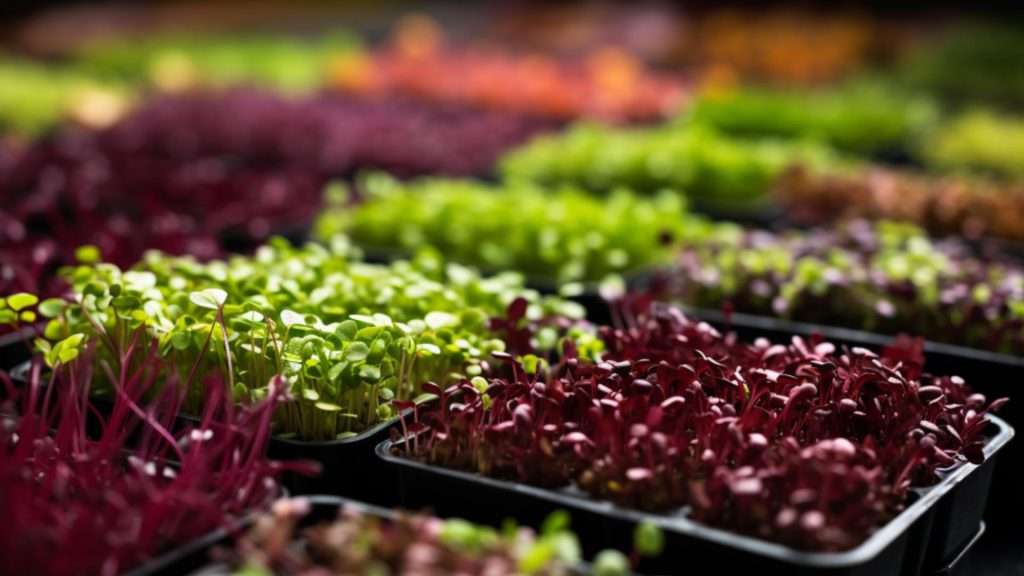
If you’re looking to add some variety and flavor to your meals, you must try growing microgreens like Mustard, Peas, Beet, Radish, and Garden Cress.
These varieties not only provide a burst of taste but also offer numerous health benefits.
By incorporating these microgreens into your dishes, you can elevate the flavors while boosting your nutrient intake.
Mustard
Mustard microgreens are not only packed with flavor, but they also offer a range of health benefits that make them an essential addition to any garden. These vibrant greens have a spicy and peppery taste that adds a zing to any dish. Whether you’re adding them to salads, sandwiches, or stir-fries, mustard microgreens bring a burst of flavor that will leave your taste buds craving for more.
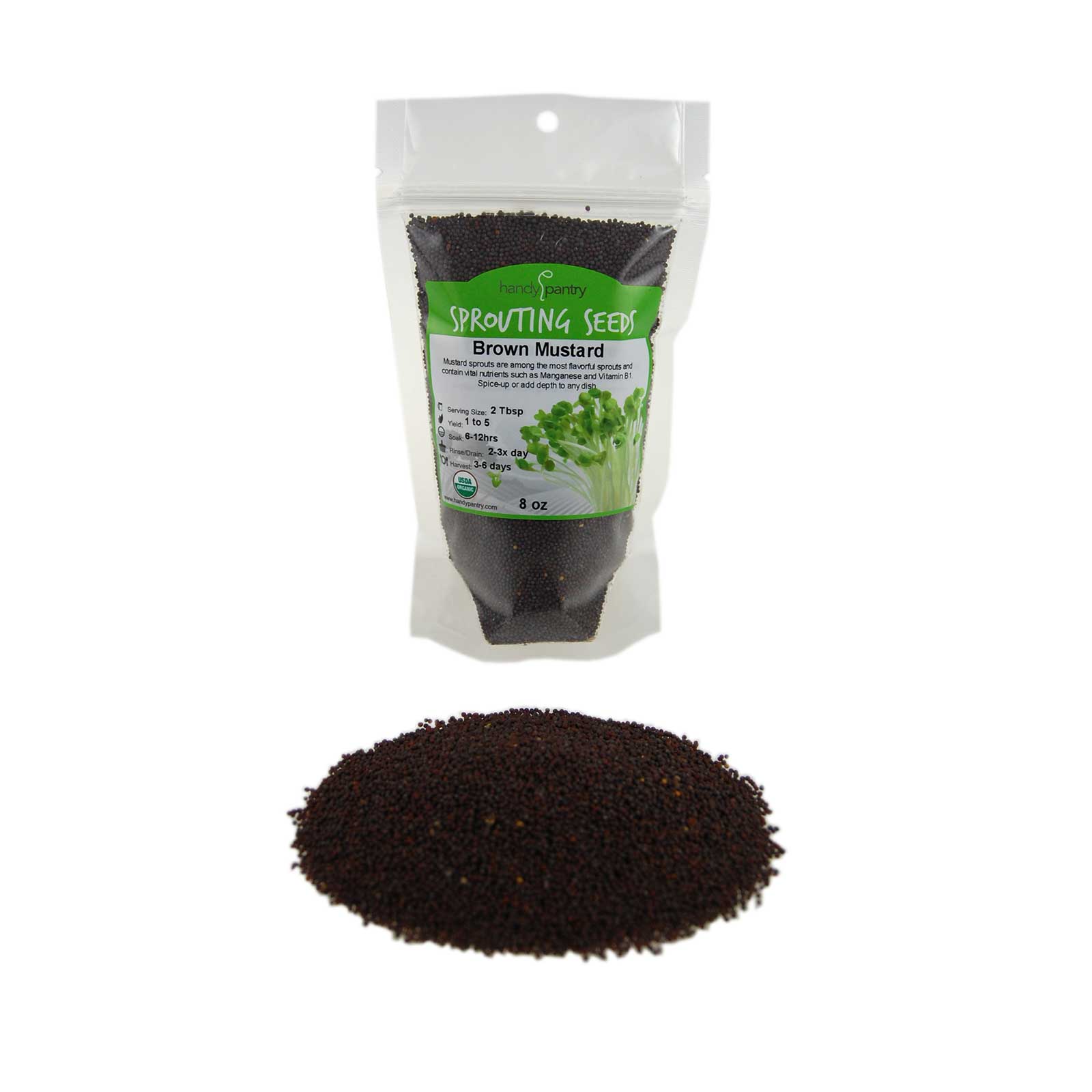
Brown mustard seeds are traditionally used to add spice to cooking. When sprouted the s… [More]
But it’s not just their delicious taste that makes mustard microgreens so special. They are also incredibly nutritious. Just like their mature counterparts, these tiny greens are rich in vitamins A, C, and K. They are also a great source of antioxidants and minerals such as calcium and potassium. Incorporating mustard microgreens into your diet can help boost your immune system, promote healthy digestion, and support overall well-being.
To showcase the versatility and variety of mustard microgreens seeds, here’s a table highlighting some other popular varieties:
| Variety | Flavor Profile | Best Paired With |
| Broccoli | Mild and earthy | Salads |
| Mix | Balanced blend | Sandwiches |
| Radish | Peppery and tangy | Stir-fries |
| Sprout | Delicate sprouts | Soups |
With this range of flavors available at your fingertips, you can mix and match different varieties to create unique culinary experiences. So why not give mustard microgreens a try? Not only will they enhance the taste of your dishes, but they also provide you with an abundance of nutrients for a healthier lifestyle.
Pea
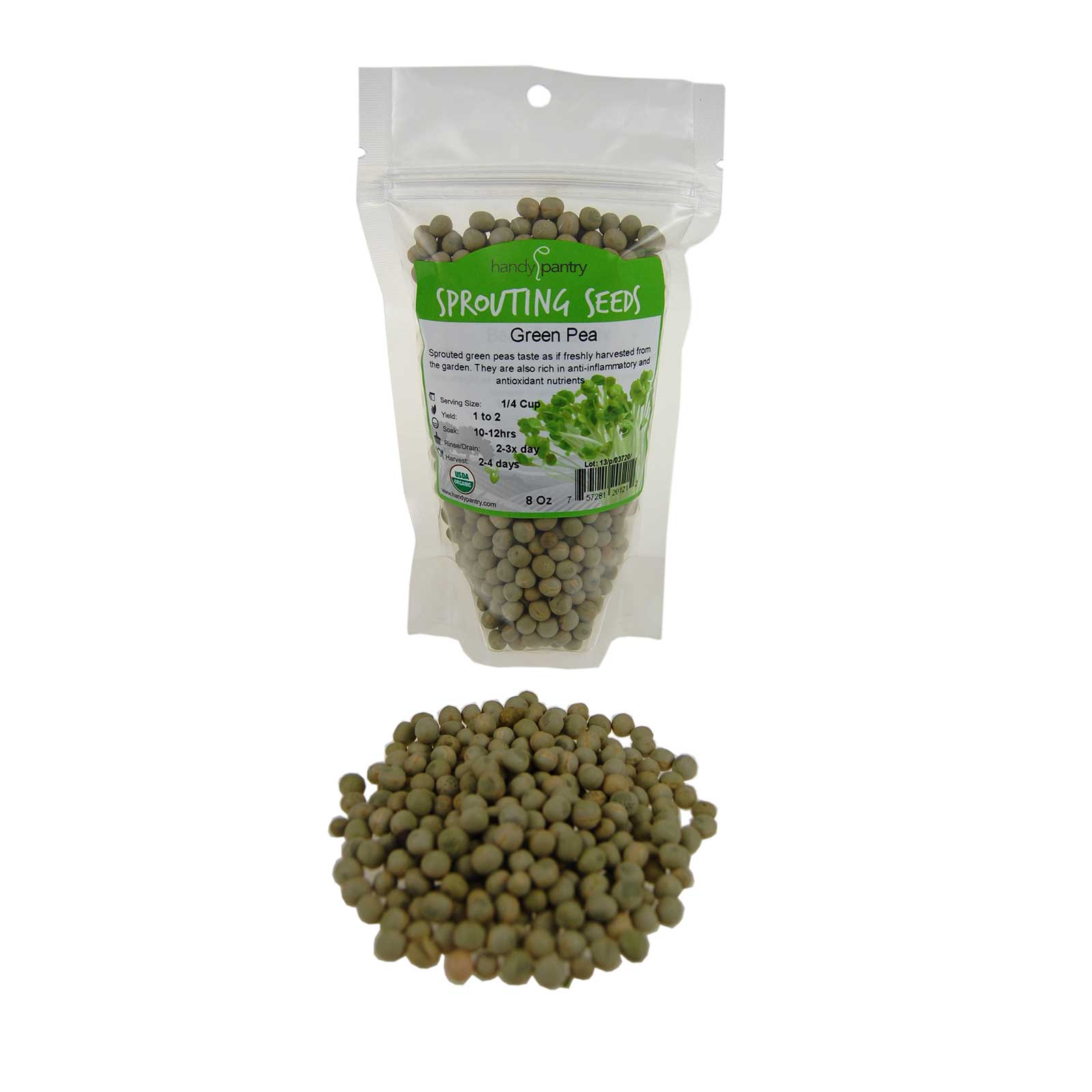
Green Pea Sprouts have a delicious crunchy mildly sweet flavor. These dried green peas… [More]
Pea microgreens are a delightful addition to any dish, bringing a burst of freshness and sweetness that’ll have your taste buds dancing with joy.
These tiny greens are packed with flavor and nutrition, making them a must-try for any microgreen enthusiast. When you grow pea microgreen seeds, you can expect a flavorful and healthy harvest that’ll elevate the taste of your meals.
Not only do pea microgreens add a pop of vibrant green color to your plate, but they also offer a unique taste that’s both mild and sweet. Their tender leaves have a delicate texture that adds depth to salads, sandwiches, and even stir-fries.
The best part is that these little powerhouses are incredibly nutritious. Pea microgreens are rich in vitamins A, C, and K, as well as essential minerals like iron and calcium.
They also contain high levels of antioxidants that help promote overall health.
So why not give pea microgreens a try? With their flavorful punch and nutritional benefits, they’re sure to become a favorite addition to your meals.
Whether you’re an experienced gardener or just starting out with microgreens, growing pea microgreen seeds is an easy way to enhance the taste and healthiness of your harvest. So, go ahead and indulge in this tiny green goodness for an explosion of flavor in every bite!
Beets
Beets are like nature’s paintbrush, splashing vibrant hues of red, purple, and gold onto your plate with each bite. These stunning microgreens are a must-have addition to your garden if you want to create visually appealing and flavorful dishes. Here are four reasons why beet microgreens seeds should be on your list:
- They’re nutrient-rich: Beet microgreens pack a powerful punch of vitamins and minerals, including vitamin C, iron, magnesium, and potassium. Adding them to your diet can help boost your immune system and support overall health.

60 days. This mix of Detroit Red and Golden beets will make for a colorful and tasty ha… [More]
- They have a unique taste: The earthy sweetness of beet microgreens adds a delightful flavor to any dish. Whether you sprinkle them on salads or use them as garnish for soups and sandwiches, their distinct taste will elevate the culinary experience.
- They have a quick harvest: Beet microgreens have a fast turnaround time from seed to harvest. Within just two weeks, you can enjoy fresh greens that are bursting with color and flavor.
- They’re versatile in recipes: From smoothies to stir-fries, beet microgreens can be incorporated into various recipes effortlessly. Their tender leaves add texture and visual appeal while infusing dishes with their natural goodness.
Including beet microgreens in your garden not only adds beauty but also enhances the nutritional value of your meals. With their quick growth cycle and versatility in dishes, these seeds are an excellent choice for a flavorful and healthy harvest.
Radishes
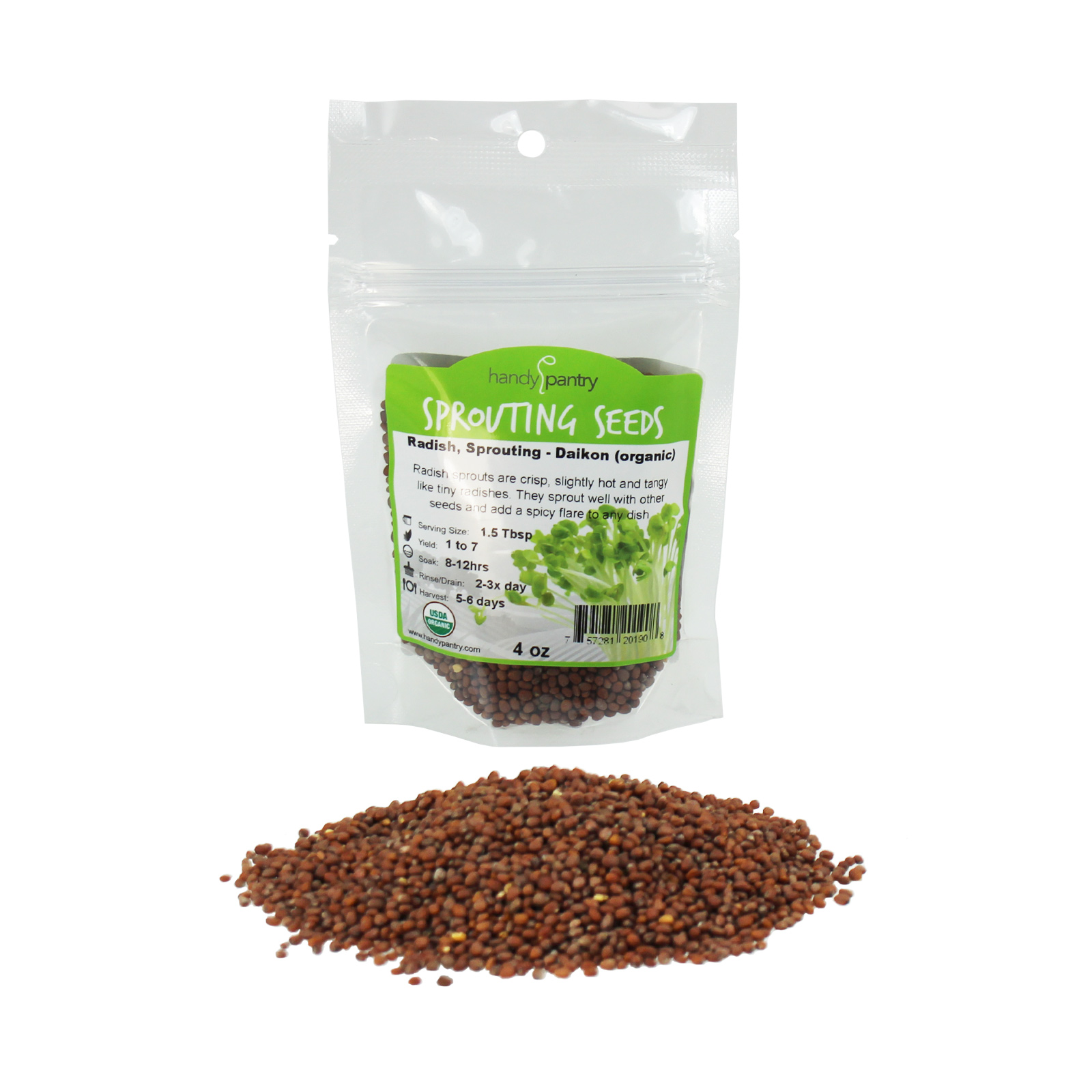
Radish Seed sprouts are high in vitamins A, B-1, B-6 and C, folic and pantothenic acids… [More]
With their vibrant and peppery crunch, radish microgreens add a burst of fiery flavor to any dish. These tiny greens are packed with nutrients and can be easily grown from radish seeds. Radish sprouting is a simple process that involves soaking the seeds overnight and then spreading them evenly on a tray filled with soil. Within a week, you’ll see the microgreens sprouting up, ready for harvest.
Not only do these microgreens enhance the flavor of your meals, but they also contribute to a healthy harvest by providing essential vitamins and minerals. The distinct flavor of radish microgreens makes them an excellent addition to salads, sandwiches, or even as a garnish for soups and stews. Their crunchy texture adds depth to any dish, while their spicy kick elevates the overall taste.
These little greens are not only delicious but also incredibly nutritious. Radish microgreens are known to be high in vitamin C, potassium, and folate, making them an excellent choice for boosting your immune system and supporting overall health. So why not give radish microgreens a try? Sprout some radish seeds today and enjoy the flavorful addition they bring to your meals while reaping all the health benefits they offer.
Garden Cress
Garden cress, also known as peppergrass, adds a zesty punch to your dishes, making them more exciting and spicing things up. As a microgreen, garden cress is packed with flavor and nutrition. When grown from seeds, it offers a variety of benefits for both your taste buds and your health.
One of the reasons why garden cress is such a flavorful addition to any meal is because its tiny leaves have a strong peppery taste. This unique flavor profile can instantly elevate the taste of salads, sandwiches, and even soups. Not only does it add an exciting burst of flavor, but garden cress also provides essential nutrients like vitamins A, C, E, and K.
.jpg)
Annual. Also called Garden Cress or Peppergrass. Ruffled leaves have a peppery and refr… [More]
These microgreens are also rich in antioxidants and minerals like calcium and iron. Incorporating garden cress into your diet not only makes your meals more delicious but also contributes to a healthier lifestyle.
Whether you’re looking for a way to enhance the flavors in your dishes or want to boost the nutritional value of your meals, garden cress is one microgreen variety you must try. Its distinct peppery taste will leave you craving for more, while its nutrient-packed properties support overall well-being.
So go ahead and sprinkle some garden cress on top of your favorite recipes for a flavorful and healthy harvest!
Arugula
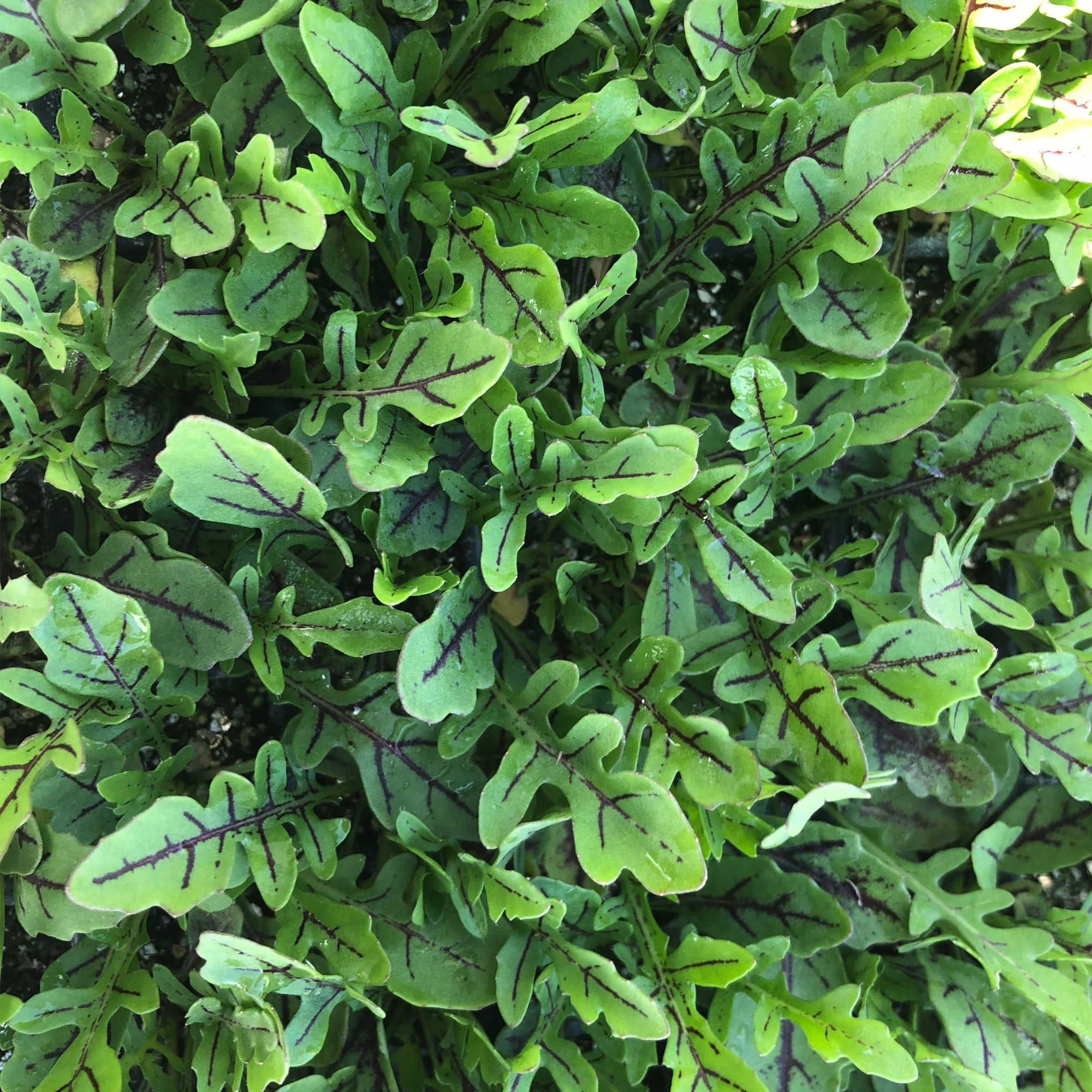
Red Streaked Arugula Seeds. 30 – 40 days to maturity. Eruca vesicaria sativa. Open Poll… [More]
Indulge your taste buds with the vibrant and peppery goodness of arugula, a leafy green that adds a burst of flavor to any dish. Arugula microgreens seeds offer a convenient way to grow this delectable green at home.
With their delicate leaves and intense flavor, arugula microgreens are not only flavorful but also packed with nutritional benefits. These tiny greens are rich in vitamins A, C, and K, as well as folate and calcium. Incorporating arugula microgreens into your diet can contribute to a healthy lifestyle by boosting your immune system, promoting bone health, and supporting overall well-being.
Growing arugula microgreens from seeds is an easy and rewarding experience. The variety of flavors available in arugula microgreens seeds allows you to experiment with different tastes in your dishes. From mild and sweet varieties to more spicy options, there’s an arugula microgreen seed for every palate.
Not only do they add a delightful kick to salads or sandwiches, but they also make a great garnish for soups or pizzas. Whether you’re looking to enhance the flavor of your meals or simply want to add some visual appeal to your plate, arugula microgreens seeds are the perfect choice for creating flavorful and healthy dishes that’ll leave you wanting more.
Basil
Now that you’ve learned about the delicious and peppery taste of arugula microgreens, let’s move on to another exciting variety – basil.
Basil microgreens are not only incredibly flavorful, but they also offer a wide range of health benefits. First and foremost, basil microgreens are packed with nutrients that contribute to a healthy harvest. These tiny greens contain vitamins A, C, and K, as well as minerals like calcium and iron. Incorporating basil microgreens into your diet can help boost your immune system, promote healthy digestion, and support bone health. Additionally, these greens are known for their anti-inflammatory properties, which can aid in reducing inflammation in the body.
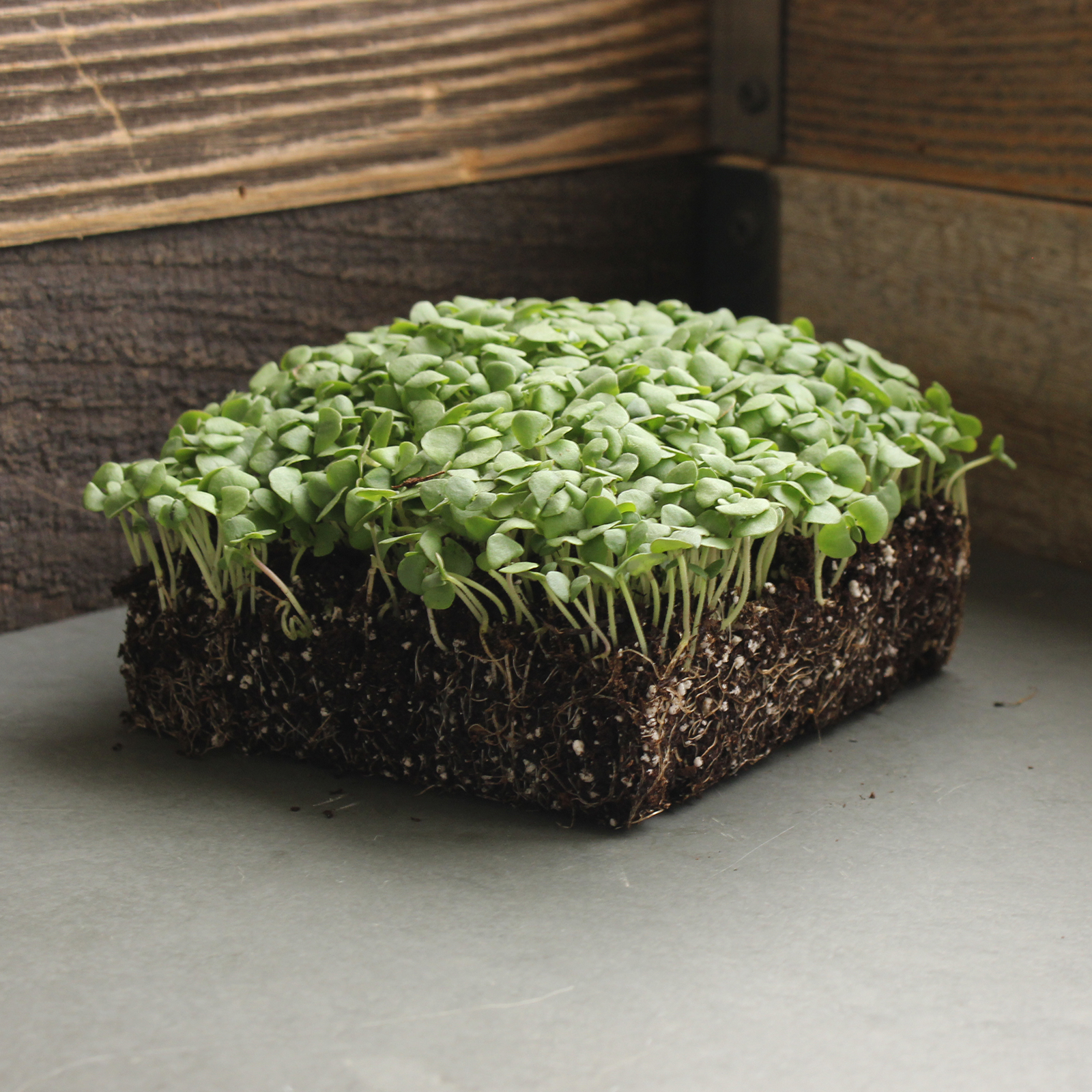
Annual. 68 days. With flavors of both traditional basil and cinnamon this strain is a S… [More]
But it’s not just the health benefits that make basil microgreens so appealing; their flavor is truly outstanding. The distinct aroma of fresh basil leaves is intensified when they are grown as microgreens. These tender greens have a sweet and slightly spicy taste that adds depth to any dish. Whether you’re sprinkling them over salads or incorporating them into pasta sauces or pesto recipes, basil microgreens will undoubtedly elevate the flavor of your meals.
To fully appreciate the amazing flavors and health benefits of basil microgreens, here are three ways to incorporate them into your dishes:
- Caprese Salad: Top slices of ripe tomatoes with mozzarella cheese and a handful of basil microgreens for a refreshing twist on this classic salad.
- Pasta Pesto: Blend together fresh basil microgreens with garlic, pine nuts, Parmesan cheese, olive oil, salt, and pepper to create a vibrant pesto sauce for your favorite pasta dish.
- Bruschetta: Spread toasted baguette slices with creamy goat cheese or ricotta cheese and sprinkle generously with basil microgreens for an appetizer bursting with flavor.
By adding these versatile varieties like arugula and basil to your collection of microgreen seeds, you’ll be on track for a flavorful and healthy harvest. Don’t be afraid to experiment with different varieties and discover new ways to incorporate microgreens into your meals. Your taste buds and your body will thank you!
Broccoli
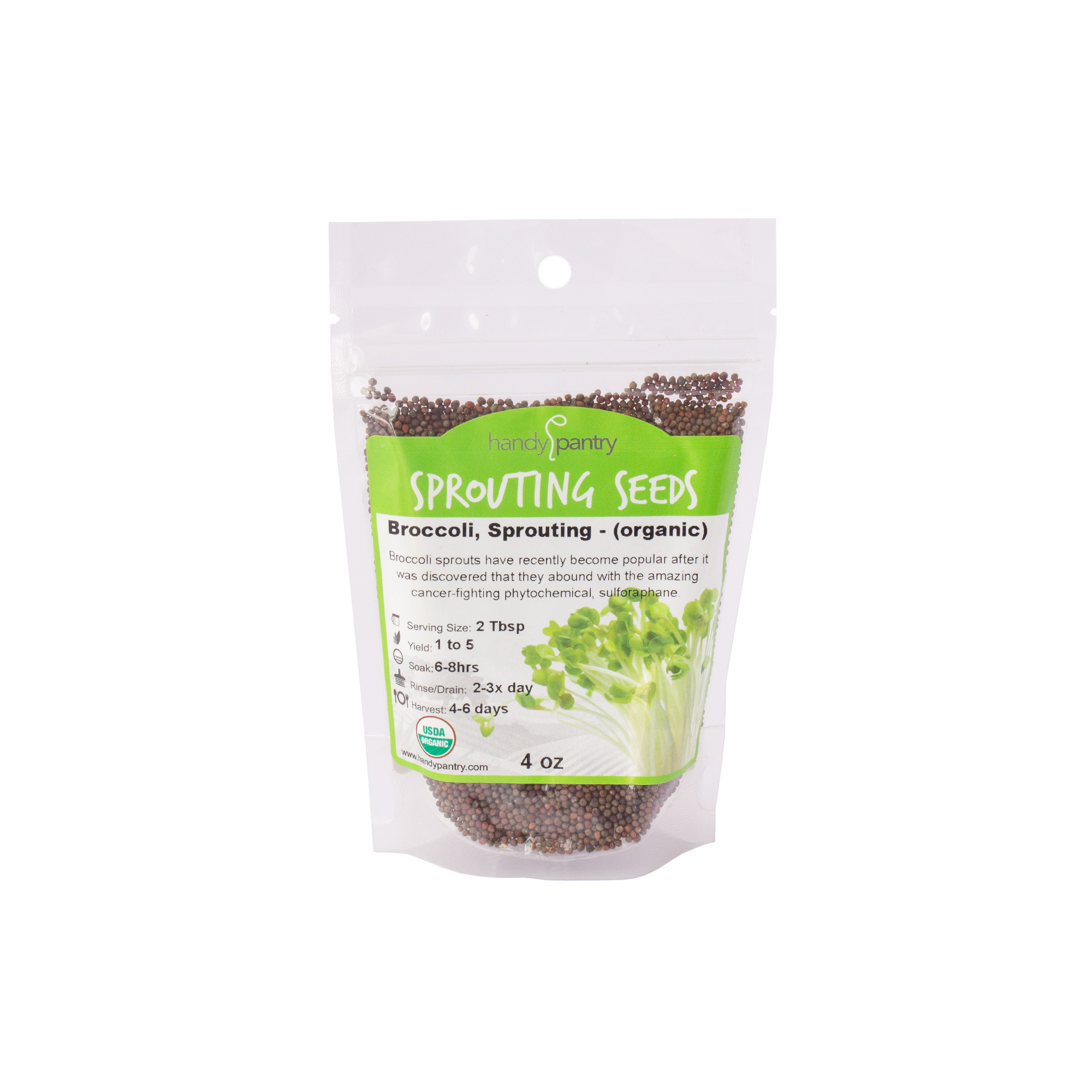
Certified Organic. Broccoli sprouting seeds. Sprouting Broccoli seeds has just recently… [More]
Broccoli microgreens, with their vibrant green color and delicate texture, are like tiny bursts of vitality in every bite. These microgreens are not only visually appealing but also packed with nutrients that contribute to a flavorful and healthy harvest. When you grow broccoli microgreens from microgreen seeds, you get the best of both worlds – the convenience and ease of growing microgreens and the nutritional benefits of broccoli.
To give you an idea of just how nutritious these microgreens are, take a look at the table below:
| Nutrient | Amount per 100g |
| Vitamin C | 89mg |
| Vitamin K | 101.6μg |
| Folate | 63μg |
| Fiber | 2.6g |
As you can see, broccoli microgreens are rich in vitamin C, which boosts your immune system, as well as vitamin K and folate, which support bone health and cell function, respectively. Additionally, they provide a good amount of fiber to aid digestion.
Not only do broccoli microgreens offer a plethora of health benefits, but they also add incredible flavor to your dishes. Their mild yet distinctive taste complements salads, sandwiches, stir-fries, and more. Incorporating these nutrient-packed greens into your meals is an excellent way to enhance both the taste and nutritional value of your dishes. So why wait? Grab some broccoli microgreen seeds today and experience the burst of flavor and vitality in every harvest!
Cilantro
Cilantro, with its vibrant aroma and bold flavor, adds a touch of freshness to any dish. When it comes to microgreens seeds, cilantro is definitely one variety you must try for a flavorful and healthy harvest. These tiny greens pack a punch of flavor that can elevate the taste of your meals. Whether you sprinkle them on top of tacos or blend them into a zesty salsa, cilantro microgreens will add a burst of freshness that will leave your taste buds craving for more.
Not only are cilantro microgreens delicious, but they also offer numerous health benefits. Packed with essential vitamins and minerals, these greens are a great addition to any diet. They’re rich in antioxidants that help fight inflammation and boost your immune system.
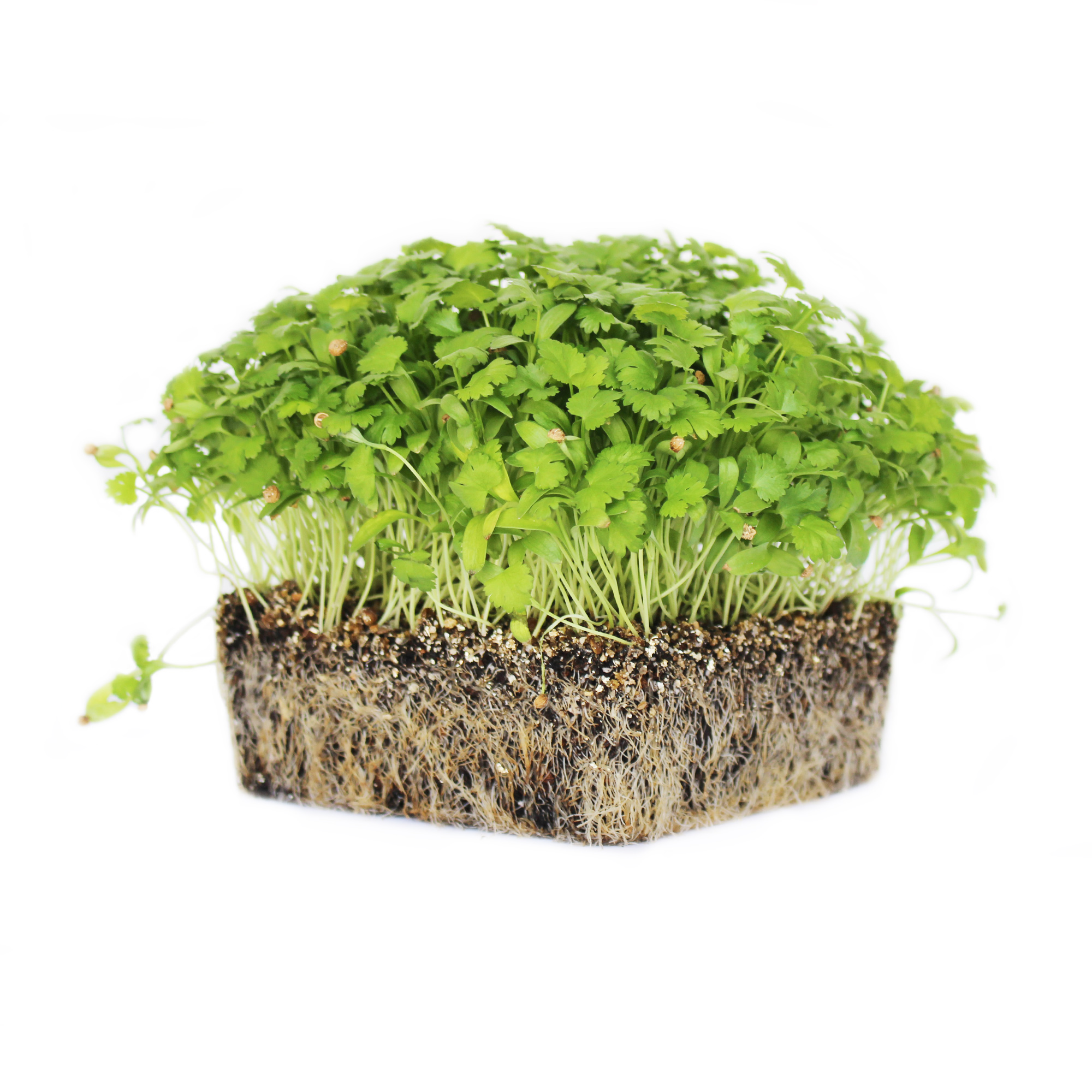
Organic. Non-GMO. Coriandrum sativum. Cilantro seed is actually a dried ripe fruit. Lei… [More]
Cilantro microgreens are also known for their detoxifying properties, helping to cleanse your body from harmful toxins. So not only do they enhance the flavor of your dishes, but they also contribute to your overall well-being.
Incorporating cilantro microgreens into your meals is an easy way to add both flavor and nutrition to your diet. So why not give it a try? Sprinkle some cilantro microgreens on top of soups, salads, or even scrambled eggs for an extra kick of freshness and healthiness in every bite. Your taste buds and body will thank you!
Kale
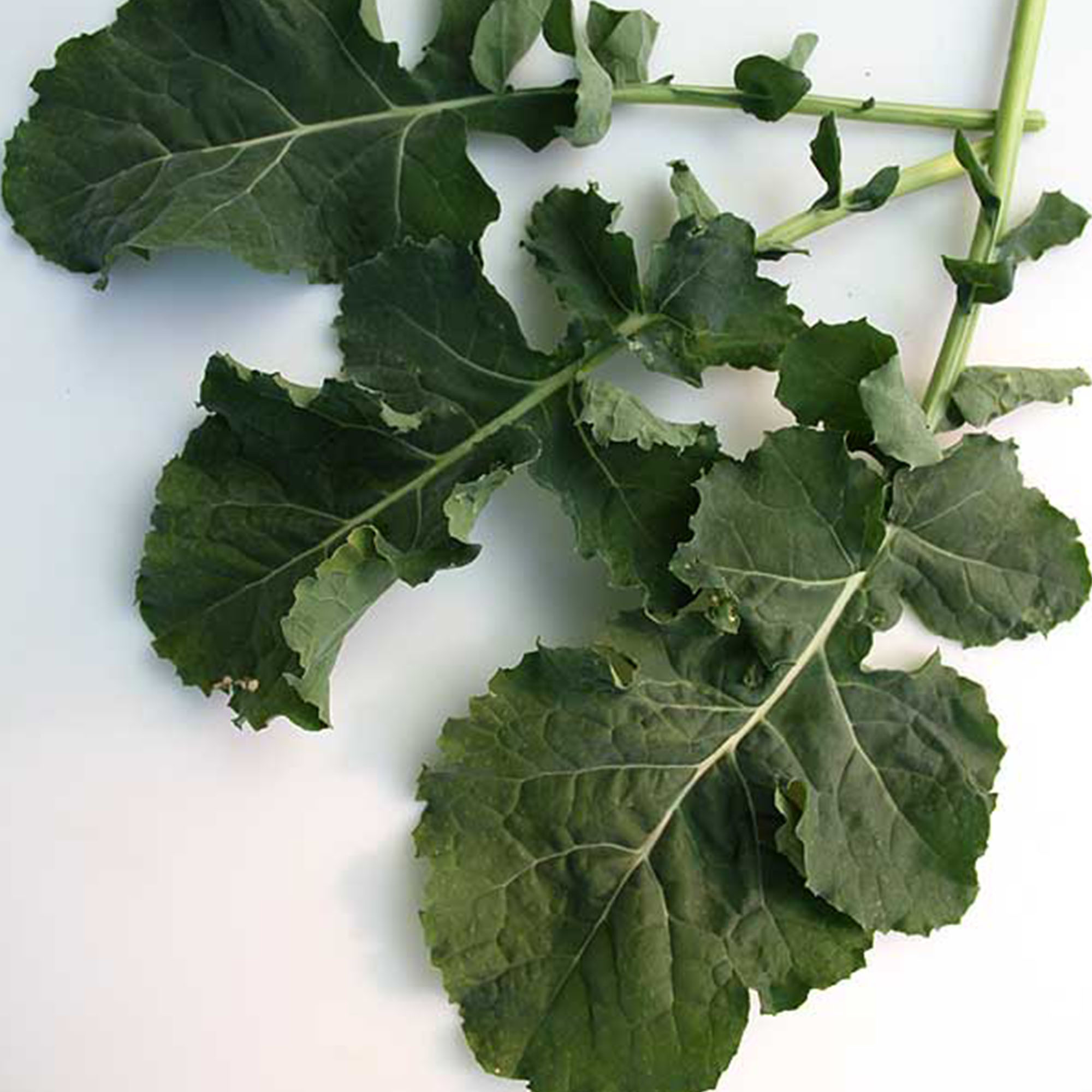
60 days. An early kale with scalloped green leaves. More smooth and tender than some … [More]
Indulge in the vibrant and nutrient-packed world of kale, where its leafy greens offer a multitude of benefits for your taste buds and overall well-being.
When it comes to microgreens seeds, kale is definitely one variety you must try for a flavorful and healthy harvest. Not only does kale provide a burst of flavor to any dish, but it’s also packed with essential vitamins and minerals that can enhance your health.
Kale microgreens are known for their distinct earthy flavor that adds depth to salads, sandwiches, and even smoothies. These tiny greens pack a punch when it comes to nutrition as well.
They’re rich in vitamin K, which supports bone health and blood clotting, as well as vitamin C, which boosts your immune system and promotes collagen production.
Additionally, kale microgreens contain antioxidants like beta-carotene and lutein that protect against cellular damage caused by free radicals. Incorporating these microgreens into your diet can not only make your meals more delicious but also contribute to a healthier lifestyle overall.
So why wait? Start growing kale microgreens from seeds today! With their flavorful taste and numerous health benefits, they’re an excellent addition to any home garden or kitchen.
Enjoy the satisfaction of harvesting your own nutritious greens while adding a burst of flavor to your favorite dishes. Whether you’re an experienced gardener or just starting out, exploring the world of kale microgreens will undoubtedly elevate both your culinary adventures and well-being.
Benefits of Growing and Eating Microgreens

If you’re looking to boost your nutrition and add flavor to your meals, growing and eating microgreens is a great idea. These tiny greens pack a powerful punch when it comes to nutritional value. They offer high levels of vitamins, minerals, and antioxidants. Not only do they taste great, but they’re also incredibly easy to grow at home. They require minimal space and care. Plus, the best part is that you can enjoy their fresh flavors in just a few weeks from planting.
Whether you want to add them to salads, sandwiches, or smoothies, microgreens are versatile in culinary uses. They can elevate any dish with their vibrant colors and delicate textures.
High nutritional value
Boost your health and taste buds by exploring the nutritional powerhouse offered by these ten microgreens varieties.
Microgreens seeds come in a wide range of varieties, each offering its own unique flavor profile and health benefits. From spicy radish microgreens to earthy beet microgreens, there’s something to suit every palate.
These tiny greens may be small in size, but they pack a punch when it comes to their nutritional value. Packed with essential vitamins, minerals, and antioxidants, microgreens are a great addition to any diet. Incorporating these flavorful greens into your meals won’t only enhance the taste but also provide you with a healthy harvest.
One of the most remarkable aspects of microgreens is their high nutritional value. Despite their small size, they’re densely packed with nutrients that can greatly benefit your overall well-being. Studies have shown that microgreens contain higher levels of vitamins and minerals compared to their mature counterparts. For example, red cabbage microgreens have been found to contain up to six times more vitamin C than regular cabbage!
Additionally, these greens are rich in antioxidants that help protect against cell damage caused by free radicals in the body. By including a variety of microgreens in your diet, you can ensure that you’re getting an abundance of essential nutrients for optimal health.
Incorporating different varieties of microgreens seeds into your diet can lead to a flavorful and healthy harvest while providing high nutritional value. These tiny powerhouses offer an array of flavors that’ll satisfy your taste buds while boosting your overall health.
With their concentrated levels of vitamins, minerals, and antioxidants, microgreens are an excellent addition to any meal or snack. So why not give them a try? Explore the world of microgreens today and reap the benefits they have to offer for both your palate and well-being!
Boosted flavor
Enhance your meals with an explosion of taste by incorporating a variety of microgreens into your dishes. These tiny powerhouses of flavor not only add a burst of freshness to your meals but also pack a punch when it comes to taste.
With the wide range of microgreen seeds available, you can experiment with different varieties to create a truly flavorful and healthy harvest. Microgreens seeds offer an incredible array of flavors that can take your dishes to the next level. From peppery radish microgreens to tangy mustard greens, there’s something for every palate.
The intense flavors of these tiny greens can transform a simple salad or sandwich into a culinary masterpiece. Not only do they provide an instant burst of taste, but they also add texture and visual appeal to your dishes.
Incorporating microgreens into your meals is an easy way to boost the flavor profile while adding essential nutrients for a healthy and vibrant diet.
Easy to grow
Now that you know how microgreens can boost the flavor of your dishes, let’s talk about how easy they are to grow.
Microgreens seeds come in a variety of options that aren’t only flavorful but also perfect for beginners. Whether you have a green thumb or not, these seeds will ensure a healthy harvest that’s both delicious and nutritious.
One of the reasons why microgreens are so easy to grow is because they require very little space. You can easily grow them in small containers indoors, making them accessible for anyone, regardless of whether you live in an apartment or have a large backyard.
Additionally, these seeds germinate quickly, giving you almost instant gratification as you watch them sprout and grow within days. With minimal effort and maintenance required, growing microgreens is a hassle-free way to add freshness and nutrients to your meals.
With such an array of microgreens seed varieties available, you’ll have no trouble finding ones that suit your taste preferences. From bold and spicy arugula to mild and refreshing pea shoots, there’s something for everyone.
Not only do these tiny greens pack a punch when it comes to flavor, but they’re also packed with essential vitamins and minerals that contribute to a healthy diet. So, don’t hesitate. Get started on growing your own microgreens today for a flavorful and healthy harvest that’s as easy as can be!
Short harvesting time
Experience the satisfaction of harvesting your own vibrant and nutrient-rich greens within just a short amount of time with microgreens seeds. These tiny powerhouses of nutrition are packed with flavor and can be grown easily in the comfort of your own home.
With their short harvesting time, you can enjoy the fruits of your labor in no time.
Microgreens seeds come in a variety of options that will tantalize your taste buds and provide a healthy addition to any meal. From spicy radishes to delicate sunflowers, there is a microgreen for every palate. Not only do they add a burst of flavor to dishes, but they also contain high levels of vitamins, minerals, and antioxidants.
With just a few weeks from sowing to harvest, you can quickly reap the rewards of growing these nutritious gems. So why wait? Start growing your own microgreens today and enjoy a flavorful and healthy harvest in just a short amount of time.
Versatile in culinary uses
Unleash your culinary creativity with the endless possibilities that microgreens provide, turning your kitchen into a vibrant and flavorful playground. These tiny greens may be small in size, but they pack a punch when it comes to adding flavor and texture to your dishes.
From salads to sandwiches, here are just a few ways you can incorporate microgreens into your culinary creations:
- Sprinkle them on top of soups or stews for an added burst of freshness.
- Use them as a garnish for pasta dishes or grilled meats to add color and visual appeal.
- Blend them into smoothies or juices for an extra dose of nutrients.
- Toss them into omelets or scrambled eggs for a pop of flavor.
Microgreens seeds come in a variety of flavors, ranging from mild and delicate to bold and peppery. Whether you prefer the subtle sweetness of broccoli microgreens or the spicy kick of radish microgreens, there is a flavor profile to suit every palate.
Not only do these tiny greens enhance the taste of your dishes, but they also provide numerous health benefits. Packed with vitamins, minerals, and antioxidants, microgreens are an excellent addition to any diet.
So why not give them a try? Experiment with different varieties and let your culinary imagination run wild with these flavorful and nutritious gems!
How to Grow Microgreens Seeds

If you want to grow microgreens from seeds, there are a few key points to consider.
First, you’ll need to soak and sterilize the seeds before planting to promote healthy growth.
Next, choosing the right growing medium is essential for providing the necessary nutrients and support.
Finally, proper watering and light conditions are crucial for ensuring optimal growth.
Soaking and sterilizing seeds
Before you begin, make sure to soak and sterilize your microgreens seeds to ensure a successful and bountiful harvest of flavorful and nutritious microgreens.
Soaking the seeds is an essential step that helps to kickstart their germination process. To do this, simply place the seeds in a container filled with clean water and let them soak for about 12-24 hours. This will help soften the seed coat and allow water to penetrate more easily, promoting faster and more uniform sprouting.
Once you have soaked the seeds, it’s important to sterilize them before planting. Sterilization helps eliminate any potential pathogens or contaminants that could hinder growth or cause diseases in your microgreens. You can sterilize your seeds by rinsing them thoroughly under running water and then soaking them in a diluted bleach solution for a few minutes. Afterward, rinse the seeds again with clean water to remove any residual bleach.
This simple yet crucial step will help create a clean growing environment for your microgreens, ensuring optimal health and flavor in your harvest. So remember, take the time to soak and sterilize your microgreen seeds before planting for a truly flavorful and healthy yield!
Choosing the right growing medium
When it comes to growing microgreens, finding the right growing medium is essential for optimum growth and plant development. The choice of growing medium can greatly impact the flavor and nutritional value of your microgreens.
There are various options available, but some popular choices include soil, coconut coir, and hydroponic mats. Soil is a traditional option that provides a natural environment for the seeds to germinate and grow. It contains essential nutrients that support healthy plant growth and offers stability to the roots.
Coconut coir is an excellent alternative as it retains moisture well while also providing good aeration for the roots. It is also a sustainable option since it’s made from coconut husks. Hydroponic mats are another viable choice as they allow for easy water retention and prevent overwatering, which can lead to root rot.
Whatever growing medium you choose, make sure it’s sterile to prevent any unwanted pests or diseases from affecting your microgreens seeds. With the right growing medium, you can ensure a flavorful and healthy harvest of your chosen microgreens varieties.
Selecting the appropriate growing medium plays a crucial role in achieving successful microgreen cultivation. Whether you opt for soil, coconut coir, or hydroponic mats, each has its own benefits in supporting optimal growth and plant development. Remember to consider factors such as nutrient content, moisture retention capabilities, and root stability when making your decision.
By choosing the right growing medium for your microgreens seeds, you’ll be on your way to enjoying a bountiful harvest of flavorful and nutritious greens.
Proper watering and light conditions
To ensure successful growth and development, it’s crucial to provide your microgreens with proper watering and adequate light conditions.
When it comes to watering, it is important to keep the soil moist but not overly saturated. Overwatering can lead to root rot and hinder the growth of your microgreens. To avoid this, water your microgreens lightly every day or every other day, depending on the moisture level of the soil. It’s also a good idea to use a spray bottle or gentle sprinkler attachment on your watering can to prevent disturbing the delicate seeds.
In addition to proper watering, providing adequate light conditions is essential for healthy microgreen growth. Microgreens require about 12-16 hours of light each day for optimal photosynthesis and nutrient absorption. If you don’t have access to natural sunlight, you can use grow lights specifically designed for indoor gardening. Keep the lights about 2-4 inches above the tops of your microgreens to ensure they receive enough light without becoming too hot or scorched.
By giving your microgreens the right amount of water and light, you’ll be on track toward a flavorful and bountiful harvest of these nutritious greens.
Harvesting and storing techniques
Now that you have mastered the art of proper watering and light conditions for your microgreens seeds, it’s time to move on to the next crucial step: harvesting and storing techniques. These techniques are essential to ensure that you not only achieve a flavorful and healthy harvest but also maintain the freshness and quality of your microgreens for an extended period.
When it comes to harvesting microgreens, timing is key. You want to wait until your plants have reached their ideal stage of growth, which is typically when they have developed their first true leaves. This ensures that the flavors are at their peak and the nutritional content is optimized. To harvest, simply use a pair of clean scissors or a sharp knife to cut the stems just above soil level. Be sure to handle them gently to avoid damaging the delicate leaves.
Once you have harvested your microgreens, it’s important to store them properly to maintain their flavor and freshness. One effective method is to use airtight containers or resealable bags lined with paper towels. This helps absorb any excess moisture while still allowing some airflow. Store them in the refrigerator at around 40°F (4°C) to slow down any further growth and extend their shelf life. Remember to label each container with the variety and date of harvest for easy identification.
To give you a better idea of which varieties of microgreen seeds you should try for a flavorful and healthy harvest, take a look at this table:
| Variety | Flavor Profile |
| Radish | Peppery |
| Sunflower | Nutty |
| Broccoli | Mildly bitter |
| Cilantro | Fresh, herbal |
| Beet | Earthy |
By incorporating these harvesting and storing techniques into your routine, you can enjoy an abundance of flavorful microgreens all year round while ensuring they stay fresh as long as possible. So get ready to savor the taste of these vibrant and nutrient-packed greens by mastering the art of harvesting and storing your microgreens seeds.
Tips for Success in Growing Microgreens
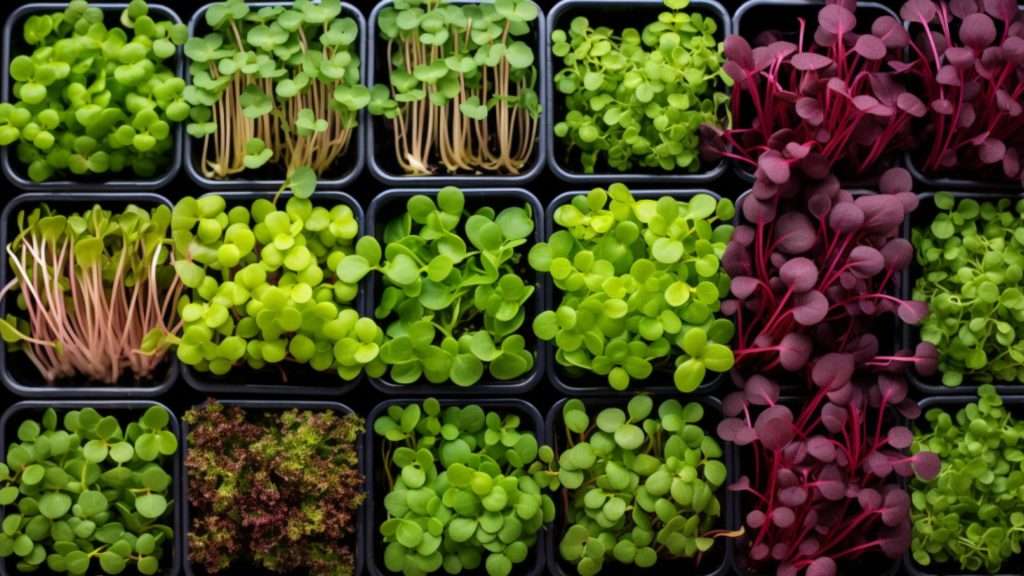
To ensure success in growing microgreens, you need to follow a few key points.
First, make sure to use high-quality seeds, as this will greatly impact the flavor and health benefits of your harvest.
Additionally, maintaining proper humidity levels and ensuring good air circulation is essential for healthy growth.
Lastly, practicing crop rotation will help prevent disease and maintain soil fertility.
Use high-quality seeds
Using top-notch seeds is essential for a bountiful and delectable microgreens harvest. When it comes to microgreens seeds, choosing high-quality varieties can make all the difference in flavor and nutrition. Here are three reasons why investing in top-notch seeds is crucial for a flavorful and healthy harvest:
- Superior taste: High-quality microgreens seeds are carefully selected to ensure exceptional flavor profiles. These varieties are bred specifically for their delicious taste, which can range from mild and nutty to tangy and peppery. By using premium seeds, you can elevate the flavors of your dishes with vibrant and aromatic microgreens.
- Nutritional value: Not all microgreens seeds are created equal when it comes to nutritional content. Opting for high-quality seeds means you’ll be growing microgreens that are packed with vitamins, minerals, and antioxidants. These nutrient powerhouses can provide a significant boost to your overall health while adding vibrant colors and fresh flavors to your meals.
- Consistent growth: High-quality microgreens seeds have been tested extensively for germination rates, ensuring a higher success rate when it comes to sprouting and growing into lush greens. This means you’re more likely to have a consistent crop with uniform growth, allowing you to enjoy a plentiful harvest of tender shoots every time.
Using high-quality microgreen seeds is essential if you want to achieve a flavorful and healthy harvest. These superior varieties offer superior taste, enhanced nutritional value, and consistent growth patterns that’ll elevate your culinary creations like never before. Invest in top-notch seeds today for an abundance of delicious and nutritious microgreens at your fingertips.
Maintain proper humidity levels
Achieving the perfect growing conditions for your microgreens is like finding the sweet spot in a symphony, and maintaining proper humidity levels is the key to cultivating a harmonious environment. Just as each instrument plays a crucial role in creating beautiful music, each aspect of growing microgreens contributes to their flavorful and healthy harvest. When it comes to humidity, finding the right balance is essential. Too much moisture can lead to mold growth and rot, while too little can result in stunted growth and wilting.
To help you navigate this delicate balance, here’s a handy table showcasing recommended humidity levels for some popular microgreens varieties:
| Microgreen Variety | Recommended Humidity Level |
| Radish | 40-60% |
| Pea Shoots | 50-70% |
| Sunflower | 40-60% |
| Broccoli | 50-70% |
| Arugula | 40-60% |
By maintaining these humidity levels, you ensure that your microgreens thrive and develop their distinct flavors. Remember that different seeds may have slightly different requirements, so it’s important to research specific guidelines for each variety you’re cultivating. With the right humidity levels in place, you’ll be well on your way to harvesting an abundance of flavorful and nutrient-rich microgreens that will elevate any dish with their vibrant colors and fresh taste.
Ensure good air circulation
Ensuring good air circulation throughout your growing space is vital for creating an optimal environment that promotes the development and growth of your microgreens. Proper air circulation helps to prevent the buildup of excessive heat and humidity, which can lead to mold and disease. It also ensures that carbon dioxide is evenly distributed, allowing for efficient photosynthesis and nutrient absorption.
Here are a few ways you can ensure good air circulation in your microgreens garden:
- Use fans: Placing fans strategically around your growing area will help to circulate the air and prevent stagnant pockets from forming. This will not only keep your microgreens cool but also strengthen their stems and promote overall growth.
- Space out trays: When setting up your trays or containers, make sure there is enough space between them to allow for proper airflow. This will prevent overcrowding and allow each microgreen to receive adequate ventilation.
By prioritizing good air circulation in your microgreens garden, you’re setting yourself up for a flavorful and healthy harvest. The improved airflow will help to keep pests at bay, reduce the risk of diseases, and ensure that each microgreen receives the nutrients it needs to thrive.
So don’t overlook this crucial aspect of gardening; instead, take the time to create an environment where fresh air can freely flow around your precious microgreens seeds.
Practice crop rotation
Now that you’ve ensured good air circulation for your microgreens, it’s time to take another important step towards a flavorful and healthy harvest: practicing crop rotation. Crop rotation is the practice of changing the location of crops from one season to another in order to prevent the buildup of pests, diseases, and nutrient deficiencies in the soil. By rotating your microgreens varieties each growing season, you can maintain the health and productivity of your garden.
Crop rotation offers several benefits for your microgreens. Firstly, it helps prevent pest and disease problems. Different varieties have different susceptibilities to pests and diseases, so by rotating them, you reduce the risk of a particular pest or disease becoming established in your garden. Secondly, it helps improve soil fertility. Different plants have different nutrient requirements, so by rotating crops that have different nutrient needs, you can ensure that all nutrients are utilized effectively and replenished naturally over time. Lastly, crop rotation also helps break up soil-borne pathogens’ life cycles by interrupting their ability to survive on specific plant types.
To give you a better idea of how crop rotation can work with microgreens seeds varieties, here’s a helpful table:
| Season | Variety 1 | Variety 2 | Variety 3 | Variety 4 |
| Spring | Radish | Pea | Sunflower | Broccoli |
| Summer | Basil | Cabbage | Kale | Mustard |
| Fall | Arugula | Beet | Chard | Cilantro |
| Winter | Spinach | Wheatgrass | Red Amaranth | Mizuna |
By following this simple crop rotation plan for your microgreens seeds varieties throughout the year, you’ll be able to maximize flavor and nutrition while keeping your garden vibrant and healthy. So go ahead and give it a try, and watch your microgreens thrive!
Using Microgreens in Recipes

If you’re looking to add a burst of flavor and nutrition to your meals, microgreens are the way to go. These tiny greens pack a punch and can be used in a variety of ways. Try tossing them into salads or sandwiches for an extra crunch. They are also great for garnishing your dishes, adding an appealing visual element. You can even blend them into your favorite juicing or smoothie recipes for a healthy boost. Additionally, microgreens can be thrown into soups and stir-fries to amp up the taste and texture.
Salads and sandwiches
When it comes to salads and sandwiches, you can’t go wrong with adding microgreens – they not only enhance the flavor but also provide a whopping 40 times more nutrients than their mature counterparts. These tiny greens pack a punch in terms of both taste and nutrition. Not only do they add a burst of freshness to your meals, but they also come in various flavors that can complement different dishes perfectly. With microgreens seeds, you have endless options for creating flavorful and healthy salads and sandwiches.
To give you an idea of the variety available, here are three popular microgreens varieties that work exceptionally well in salads and sandwiches:
| Variety | Flavor | Pairing |
| Arugula | Peppery | Goat cheese, tomatoes |
| Radish | Spicy | Avocado, cucumber |
| Sunflower | Nutty | Turkey, sprouts |
These are just a few examples among many other exciting options like broccoli, kale, or mustard microgreens seeds. The beauty of microgreens is that they bring unique flavors to your dishes while also providing an extra boost of vitamins and minerals. So next time you’re making a salad or sandwich, don’t forget to sprinkle some microgreens on top for added flavor and nutrition.
Garnishing dishes
Enhance your dishes with a pop of color and flavor by garnishing them with these vibrant and tasty microgreens. Whether you’re serving up a gourmet meal or simply adding some pizzazz to your everyday dishes, microgreen seeds offer a variety of options for garnishing that are both flavorful and healthy.
From delicate arugula to spicy radish, these tiny greens pack a punch in terms of taste and nutritional value. When it comes to garnishing dishes, microgreen seeds provide an array of choices that can suit any palate. The flavors range from mild and earthy to bold and peppery, allowing you to experiment with different combinations to find the perfect match for your dish.
Not only do they add an aesthetic appeal with their vibrant colors, but they also bring a burst of freshness that elevates the overall taste experience. Sprinkle some tangy mustard microgreens on top of your salads or sandwiches for an added kick, or use cilantro microgreens as a finishing touch on your Mexican-inspired dishes. With so many varieties available, you can easily create visually appealing plates that are bursting with flavor while also providing essential nutrients for a truly healthy harvest.
Whether you choose to incorporate vibrant radish microgreens for a spicy crunch or opt for delicate pea microgreens to add a touch of sweetness, the possibilities are endless for elevating your culinary creations and enhancing their nutritional value.
Juicing and smoothies
Now that you’ve discovered the art of garnishing dishes with microgreens, it’s time to take your culinary journey to the next level. Enter the world of juicing and smoothies, where microgreens seeds truly shine.
These tiny powerhouses pack a punch when it comes to flavor and nutrition, making them a must-try ingredient for all your refreshing beverages.
When it comes to juicing, microgreens seeds offer an array of exciting possibilities. From vibrant green spinach microgreens to zesty radish microgreens, there are endless varieties to choose from. Each variety brings its own unique flavor profile, adding depth and complexity to your juices.
Imagine sipping on a refreshing carrot and beet juice infused with the delicate peppery notes of cilantro microgreens or enjoying a tropical smoothie enhanced by the sweet aroma of pineapple sage microgreens. Not only do these seeds provide an explosion of taste, but they also offer an abundance of health benefits.
Incorporating microgreens seeds into your juicing routine ensures that you’re getting a concentrated dose of vitamins, minerals, and antioxidants in every sip. These little greens are packed with essential nutrients like vitamin C and vitamin K while being low in calories. They also contain high levels of enzymes that aid digestion and promote overall gut health.
So why not elevate your juicing game by adding some flavorful and nutritious microgreens seeds? Your taste buds and body will thank you for it!
Adding to soups and stir-fries
Take your soups and stir-fries to new heights by incorporating the vibrant and nutrient-packed punch of microgreens. These tiny greens, grown from microgreens seeds, aren’t just visually appealing but also add a burst of flavor to your dishes.
With their delicate texture and intense taste, microgreens can elevate the overall taste profile of your soups and stir-fries. Whether you choose peppery arugula microgreens or tangy radish microgreens, these varieties offer a range of flavors that’ll leave your taste buds wanting more.
Not only do microgreens add flavor to your soups and stir-fries, but they also contribute to a healthy harvest. Packed with essential vitamins, minerals, and antioxidants, these young greens provide a nutritional boost to any meal.
Including microgreens in your dishes ensures that you’re getting a dose of vitamins A, C, and K, as well as folate and potassium. So why settle for plain old vegetable soup or stir-fried vegetables when you can take them up a notch by sprinkling some colorful microgreens on top?
Experiment with different varieties of microgreens seeds in your cooking to create unique flavor combinations that’ll impress both your family and guests alike.
Purchasing Microgreens Seeds

Looking to purchase microgreens seeds? You’re in luck! There are many options available for you.
Whether you prefer organic and non-GMO seeds or want to explore different seed suppliers and online stores, there is something out there for everyone.
So go ahead and start your search for the perfect microgreens seeds to kickstart your flavorful and healthy harvest!
Where to buy
If you’re wondering where to buy microgreens seeds, there’s a theory that local farmer’s markets often have a wide selection of high-quality varieties. Supporting small businesses is not only great for the community but also ensures you get fresh and organic seeds. Many small business brands specializing in microgreens seeds can be found in these markets, offering a diverse range of options such as arugula, broccoli, radish, and more. Not only will you be able to find unique heirloom varieties that add flavor and character to your dishes, but you’ll also have the opportunity to learn from experienced growers who are passionate about their craft.
Another convenient option for purchasing microgreens seeds is through online delivery services, like True Leaf Market. Many small businesses now offer their products online, allowing you to browse through an extensive selection without leaving the comfort of your home. These online platforms often provide detailed information about each variety, including growing tips and nutritional benefits. Plus, they usually offer organic options if you prefer to grow your microgreens using natural methods. By opting for delivery from small businesses, you support local economies while enjoying the convenience of having high-quality seeds delivered straight to your doorstep. So whether it’s at farmer’s markets or through online delivery services, finding the perfect microgreens seeds has never been easier or more accessible!
Organic and non-GMO options
For an enjoyable and convenient way to add a touch of nature to your meals, consider exploring the wide selection of organic and non-GMO options available when purchasing microgreens seeds. Opting for organic microgreens seeds ensures that you’re getting a product that’s grown without the use of synthetic fertilizers, pesticides, or genetically modified organisms.
This means that you can enjoy your flavorful and healthy harvest knowing that it was produced in a sustainable and environmentally-friendly manner.
When choosing organic microgreens seeds, there are several varieties to choose from. Here are three options that’ll not only provide you with delicious flavors but also contribute to a nutritious diet:
- Organic broccoli microgreens seeds: These tiny greens pack a punch when it comes to flavor. With their slightly spicy taste, they’re perfect for adding some zing to salads or sandwiches.
- Organic sunflower microgreens seeds: Sunflower microgreens have a mild nutty flavor that adds depth to any dish. They’re rich in vitamins A and E, making them an excellent choice for boosting your immune system.
- Organic radish microgreens seeds: If you’re looking for a peppery kick, radish microgreens are the way to go. Not only do they add a burst of flavor to your meals, but they also contain high levels of vitamin C and antioxidants.
By opting for organic options when purchasing microgreens seeds, you can ensure that you’re not only enjoying flavorful additions to your meals but also supporting sustainable farming practices and promoting overall health and well-being.
Seed suppliers and online stores
Check out the wide array of seed suppliers and online stores that offer a variety of options for adding a touch of nature to your meals with organic and non-GMO microgreens seeds.
When it comes to choosing the right seed supplier, it’s important to consider factors such as reputation, quality, and variety. Some popular seed suppliers include Johnny’s Selected Seeds, True Leaf Market, and Baker Creek Heirloom Seeds. These suppliers offer a diverse selection of microgreen seeds, ranging from classic varieties like broccoli and radish to more unique options like amaranth and sorrel. By exploring different seed suppliers, you can find the perfect seeds to create a flavorful and healthy harvest.
In addition to individual seed suppliers, there are also online stores that specialize in microgreens seeds. One such store is Microgreen Pros, which offers a wide range of organic and non-GMO microgreens seeds. They provide detailed descriptions of each variety along with helpful tips on growing and harvesting microgreens.
Another popular online store is Everwilde Farms, which not only offers an extensive selection of microgreen seeds but also provides information on the history and culinary uses of each variety. By browsing through these online stores, you can discover new varieties that will add excitement to your meals while ensuring they are packed with flavor and nutrition.
So go ahead and explore the many options available from these seed suppliers and online stores to find the perfect microgreens seeds for your next harvest!
Common Challenges in Growing Microgreens Seeds

Are you struggling with growing microgreens seeds?
One common challenge is preventing mold and pests. Make sure to keep your growing area clean and free from debris, and consider using organic pest control methods.
Another challenge is properly watering your microgreens. Be mindful not to over or under water, as this can lead to root rot or stunted growth.
Lastly, controlling the temperature and light levels is crucial for the success of your microgreens. Ensure they are getting enough light without being exposed to excessive heat or cold temperatures.
Mold and pests prevention
Avoid the frustration of mold and pests ruining your microgreens by implementing these effective prevention methods. When it comes to sprouting microgreens seeds, it’s important to take proactive measures to ensure a healthy harvest.
Here are some tips to keep mold and pests at bay:
- Proper ventilation: Make sure your growing area is well-ventilated to prevent moisture buildup, which can lead to mold growth. Use fans or open windows to circulate air and maintain a dry environment for your microgreens.
- Sterilize equipment: Before starting a new batch of microgreens, thoroughly clean and sterilize all trays, containers, and tools used in the growing process. This helps eliminate any potential sources of mold or pests.
- Monitor humidity levels: High humidity can create an ideal environment for mold growth. Invest in a hygrometer to monitor humidity levels in your growing area and aim for a range between 40% – 60%. If the humidity exceeds this range, consider using dehumidifiers or silica gel packs to absorb excess moisture.
By following these prevention methods, you can protect your microgreens from the threat of mold and pests, ensuring a successful harvest of flavorful and healthy varieties. Remember that proper ventilation, equipment sterilization, and monitoring humidity levels are key factors in maintaining optimal conditions for sprouting microgreens seeds.
Over or under watering
Maintaining the right balance of moisture is crucial for the successful growth of your microgreens. When it comes to watering your microgreens, finding that sweet spot can be a bit tricky.
Over-watering can lead to mold and root rot, while under-watering can cause stunted growth and poor flavor development. To ensure a flavorful and healthy harvest of your microgreens seeds, it’s important to pay close attention to their watering needs.
To begin with, it’s essential to water your microgreens seeds thoroughly but not excessively. The goal is to provide enough moisture for them to grow without drowning them in water. One way to achieve this is by using a spray bottle or misting system that delivers a fine mist of water evenly across the surface of the soil. This allows the seeds to absorb moisture gradually while preventing excessive saturation.
Additionally, monitoring the moisture levels in the soil is crucial. Stick your finger about an inch into the soil, and if it feels dry at that depth, then it’s time for watering. Remember that different varieties may have slightly different watering requirements, so observe each variety individually and adjust accordingly.
By maintaining proper watering techniques and paying attention to each variety’s specific needs, you’ll be well on your way to a flavorful and healthy harvest of microgreens seeds. Remember that finding the right balance takes practice and observation, but with time you’ll become more attuned to their moisture requirements.
So go ahead and get growing – enjoy experimenting with different varieties while ensuring they receive just the right amount of water for optimal growth!
Temperature and light control
Creating the perfect environment for growing microgreens involves carefully controlling temperature and light to ensure optimal growth and vibrant green leaves. When it comes to temperature, microgreens seeds thrive in a range of 60-75°F (15-24°C). It’s important to provide consistent warmth for germination and then gradually lower the temperature slightly as the plants grow.
This can be achieved by using a heating pad or placing the trays near a heat source. However, it’s crucial to avoid extreme temperatures as they can hinder growth or even cause damage to the delicate seedlings.
In addition to temperature, light plays a vital role in the development of microgreens. These tiny plants require sufficient light exposure to produce flavorful and healthy harvests. Ideally, microgreens should receive 12-16 hours of bright indirect sunlight each day or around 8-12 hours of artificial light if natural sunlight isn’t available.
Using fluorescent lights with a color temperature between 5000K-6500K provides the necessary spectrum for optimal growth. It’s important to keep the lights close to the plants, about 2 inches above them, and adjust their height as they grow taller.
By maintaining the proper temperature and providing adequate light, you’ll create an ideal environment that promotes robust growth and enhances the flavor of your microgreens harvest.
Final Thoughts

In the end, exploring these 10 flavorful and healthy microgreens seed varieties is like embarking on a culinary adventure that will leave your taste buds begging for more. These tiny powerhouses of nutrition not only add vibrant colors and fresh flavors to your dishes but also provide numerous health benefits. Whether you’re a seasoned chef or an amateur cook, incorporating these microgreens seeds into your meals can elevate them to a whole new level.
Here are three reasons why you should try these microgreens seed varieties for a flavorful and healthy harvest:
- Bursting with Flavor: The diverse range of microgreens seeds available ensures that there’s something to suit every palate. From the spicy kick of radish microgreens to the refreshing taste of cilantro microgreens, each variety brings its own unique flavor profile to the table.
- Nutrient Powerhouses: Despite their small size, microgreens are packed with essential vitamins, minerals, and antioxidants. Incorporating these nutrient-dense greens into your diet can help boost your immune system, improve digestion, and promote overall well-being.
- Easy to Grow: Growing your own microgreens at home isn’t just cost-effective but also incredibly simple. With minimal space requirements and quick growth cycles, even those with limited gardening experience can enjoy a bountiful harvest of fresh greens right from their kitchen countertop.
Adding these 10 varieties of flavorful and healthy microgreens seeds to your culinary arsenal will enhance both the visual appeal and nutritional value of your meals. So go ahead and embark on this exciting journey towards discovering new tastes while reaping the numerous health benefits that come along with it.
You should definitely give microgreens seeds a try if you want to add more flavor and health to your harvest. These tiny greens pack a powerful punch when it comes to taste and nutrition, making them a must-have in any kitchen.
Now, you might be thinking that growing microgreens seeds could be challenging or time-consuming. But fear not! With the right knowledge and tips, anyone can successfully grow these vibrant greens at home. Plus, the benefits of growing and eating microgreens are well worth the effort.
One objection you might have is the cost of purchasing microgreens seeds. While it’s true that some varieties can be pricier than others, remember that you only need a small number of seeds to get started. Additionally, growing your own microgreens is much more cost-effective in the long run compared to buying pre-packaged ones from the store. So don’t let concerns about finances hold you back from enjoying these nutrient-rich wonders.
Don’t miss out on the opportunity to enhance your meals with delicious and nutritious microgreens by giving their seeds a chance. With their incredible flavors and health benefits, growing your own microgreens will allow you to take control of what goes into your food while adding an exciting pop of color and taste to your dishes. So go ahead and start planting those seeds. Your taste buds and body will thank you!
Frequently Asked Questions About Microgreens Seeds

Cal Hewitt is the Founder and Lead Cultivator at Microgreens Guru, a website dedicated to empowering individuals to grow, consume, and potentially sell nutrient-dense microgreens. With 5 years of hands-on experience in microgreens cultivation, Cal brings a unique analytical perspective to the world of urban agriculture. He specializes in optimizing growth techniques for various microgreen varieties, while also focusing on sustainable and cost-effective growing methods. Cal’s passion for microgreens, ignited by a personal health journey, drives him to continuously explore and share innovative approaches to microgreens cultivation. His practical experience, combined with his commitment to education through his website and upcoming book, ensures that Microgreens Guru remains a valuable resource for both novice and experienced growers alike.







